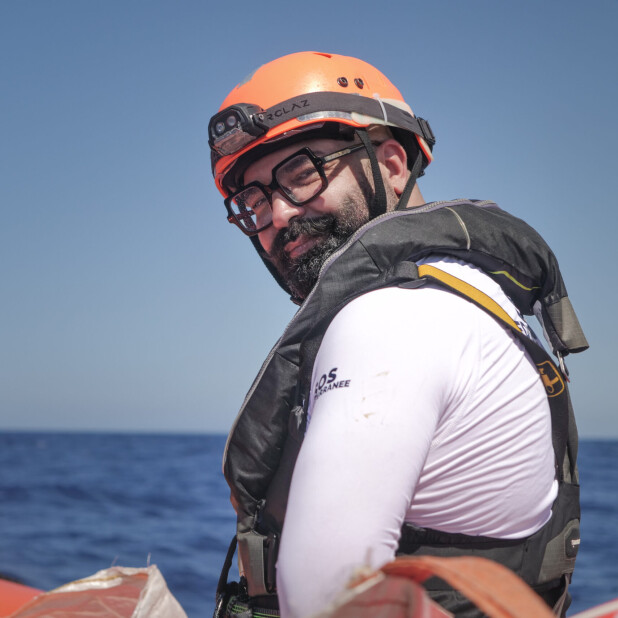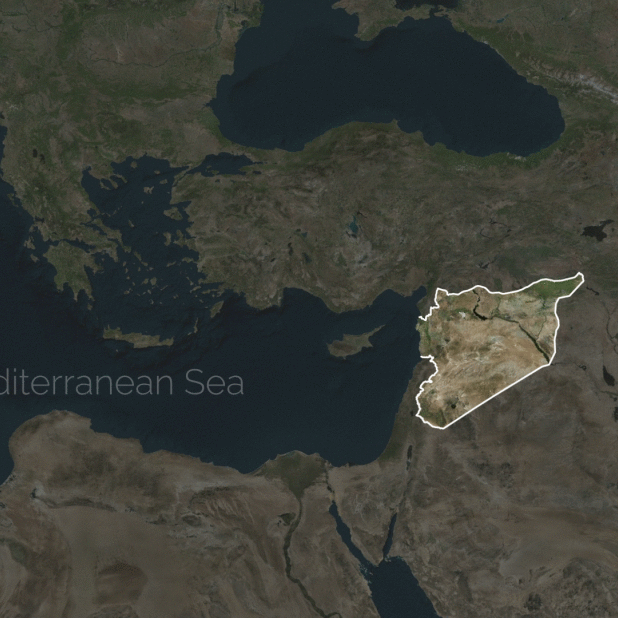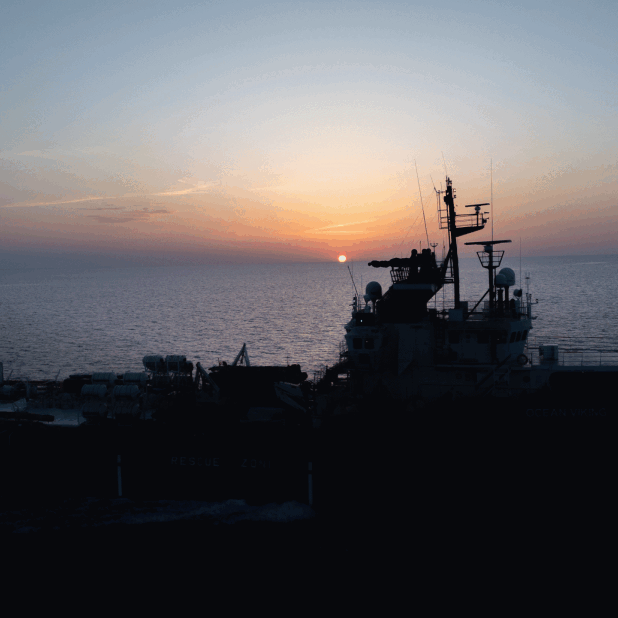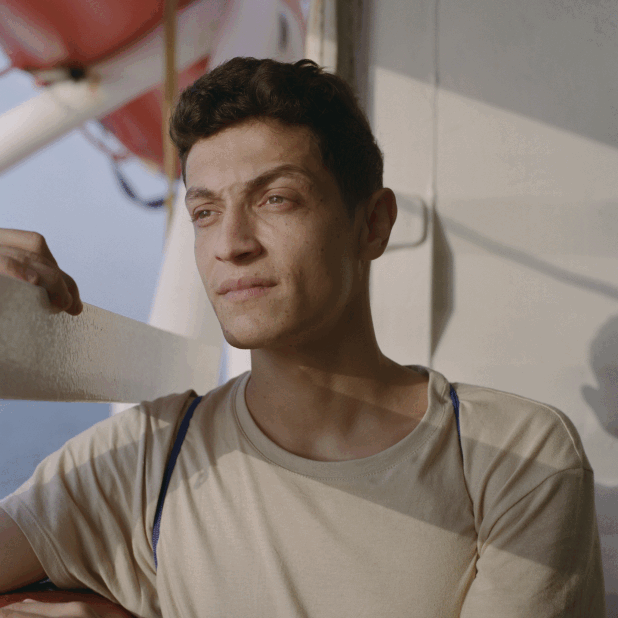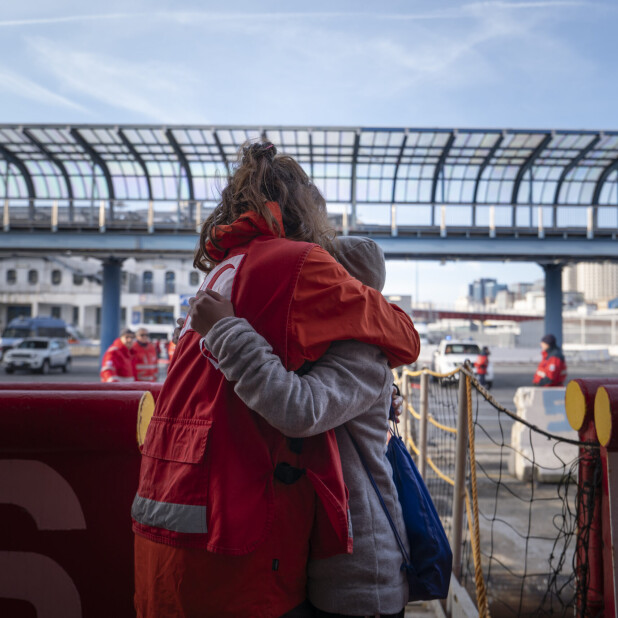
Guillaume first joined the SOS MEDITERRANEE Search and Rescue team in November 2019. Back on the Ocean Viking this spring, Guillaume shares his experiences on board with us in his journal.
First entry – April 8 to 15.
Stuck in port. The industrial docks in Augusta, Sicily, flanked the ennui on the Ocean Viking. The crew, after the last disembarkation of survivors, all tested negative to Covid-19 upon arrival in port, and then tested negative again after seven days (our nostrils stopped counting PCR and antigenic tests), but fourteen days in quarantine is fourteen days in quarantine. Waiting is the new work of humanity. What is a rescue ship tied at shore good for? Not much. Managing the pandemic forces a standstill to limit the number of deaths in hospital beds. Saving lives on land while not being able to save lives at sea if needed. A harsh realization.
The team members disembark. My family of one month is going home, to Italy, Romania, England, Belgium, the Philippines. We will probably meet again soon, in quarantine or elsewhere. Living in the confined space of a ship requires a high degree of know-how and, curiously, the sailors are quite adept at it. There is work on board and daily life, abandon ship drills and scrambled eggs for breakfast, binoculars and birthday candles, we change hats as often as necessary, we play for the same team. Substitutes arrive, drop their bags and help bring in fresh wind. Soon we set sail again.
Etna is a castle in the sky that we leave behind in our wake. Once we leave the dock, the ship is rolling. “Back at sea”, at last. The sea takes us back in, it makes me jump with joy. Well, it’s only two days at sea for now, because the weather is getting worse. Two days for our new colleagues to introduce themselves, to get to know each other, and especially to learn to work together. The RHIBs are buzzing on the water, I’m the driver on the third one, Mathieu is a crew member and Erik is the leader on this rescue boat called “Easy 3”. We practice different set-ups, combinations, all the manoeuvres, ten times, twenty times. We simulate rescues, we make up scenarios, the worst and the less bad. Training is the job of a rescuer. Rescue is training put into practice, when reality finds us. As we are still on the water, the three RHIBs and the Ocean Viking, the sea is already getting rough, the chop has taken on a metallic grey colour, it is getting worse, we have to cut a training session short and recover the three boats back onto the ship. We head for Syracuse in Sicily to seek Shelter and finish the last trainings on board. The sea is also rough in the International waters off Libya, which might prevent people from attempting to depart from its coasts. I’m more receptive to what the sea imposes rather than what our countries order. That’s probably why I like being at sea.
Second entry – April 15 to 20.
The Mediterranean is playing winter in the middle of spring. It is windy, painting old man’s hair on the back of each wave, going soft between the sun of the west and the sun of the east. We like to think of it as beautiful and peaceful, but a few hours pass and reveal its coldness and unkindness. The weather windows close as quickly as they open, this instability raises fears of critical rescues. This morning before daybreak, as we sail through International waters, I see Libya in the distance, first the lights of Men, and then the grey, hazy stretch of coastline beyond. It is there that a part of humanity has lost its grip, that weapons are used for the worst kind of submissions on those who do not have them. This is not an imaginary country, people cross it, escape on bits of rubber, forcing life to keep from dying.
With Erik, we start the daily round of the mass flotation devices, we fill some of them with air, then I climb onto a fast boat: Easy 3, the one I steer. The mooring lines are in place, the search lights forward, aft and handheld are working, so is the bilge pump, as is the VHF radio, the GPS. There is no resistance in the steering wheel that drives the outboard motor and the battery is well charged. We check twice a day that all the life-saving equipment is working properly. Matthieu draws us a portrait of his happy and funny cabin mates: Amine and François. Flavio teaches Giuseppe three guitar chords while others try to read. In the evening, when dinner time comes, everyone is hungry. We walk awkwardly as we catch the swell from the side. Sometimes in the midst of the daily grind there are bursts of laughter.
Third entry – April 20 to 23.

When I woke up on 21 April, I noticed that the Ocean Viking was running at full speed to the west-northwest. We were indeed going at 12 knots, towards a Target that had set off an alert earlier in the night, and still a few hours away: it would be a wooden boat with about 42 people on board. In the area, from sunrise to sunset, the active search with binoculars will not be successful and the sea is bad. We will never know if they escaped to a Shelter in time or if they capsized.¹
We leave this area for another Target in the east-southeast, 10 hours sailing from our current location. The sun is spreading its mercury over the surface; and the wind, once more the wind that hides in the night, comes to lift the waves far too high. I’m on the Bridge for the last hour of watch with binoculars when a “Mayday” from an aircraft confirms the distress, broadcast on VHF Channel 16 (public radio channel monitored by all ships). Luisa, the search and rescue coordinator on board, acknowledges the distress call. Emma, a journalist on board and also on the Bridge for a few hours, presses “record” at this decisive moment, perhaps by instinct.
It is a rubber dinghy in distress, with about 130 people on board, in the Libyan search and rescue zone. The Libyan coastguard, funded in part through grants from European countries, will not go out tonight. No rescue coordination centre on land is carrying out its duty to coordinate the rescue operation. Three merchant ships are actively searching for the boat in distress. Everything is dark, the features on the faces of those who are watching, the pounding of the swell on the hull, the noise that emulates the silence, the fire in the throats of those we cannot find, even the foam has given up its whiteness.
Then the day returns with its empty hours. We continue the patrol by methodically squaring the surface where we calculate the dinghy might be drifting. I go up to the Bridge with Amine for our binocular watch. And then, the wreck in the distance; a body floats in a tube which acts as a buoy, head in the water. Other bodies follow, like small white pebbles indicating the path of the wreck. It was the merchant ship MY ROSE that spotted the wreck a few hours ago.
Three merchant ships, a humanitarian ship and good seamanship: solidarity, even if it’s been damaged, still exists. European policies, on the other hand, are wandering into illegality. Even though our countries have signed the maritime conventions for the protection of human life at sea! Invisible lives, invisible deaths, they have names and surnames, families that will never know. Nobody knows because nobody wants to know. A minute’s silence, a good cry and then we start again.

Fourth entry – April 23 to May 17
I am writing during my quarantine and I try to remember in what order and how events have unfolded since the disaster of 22 April. I remember the waiting and the watches when, in the eye of the binocular, the sea said its disgust. Sobered up, and breathless for days on end, she is exhausted too from carrying all this distress. I have this tendency to anthropomorphize the Mediterranean, it relieves me of the general indifference in which humanity is immersed.
Then I stopped thinking, on 27 April, when two dinghies were reported in distress a few dozen Nautical Miles from our position. You have to see it to realise what it is, a crowd amassed on something that looks like an arrangement of plywood and inflated rubber in the middle of nothing. Children on a beach toy in the middle of a shoreless ocean. We had the luxury, finally, of calm seas and a mild sky. The three fast rescue boats were launched in the water, allowing us to assist two boats at the same time, separated by half a mile from each other. Tanguy, the search and rescue team leader, knows what he has to do. He is both conductor and town crier, calming the distressed crowd and directing the ballet of our rescue boats. One of the sponsons of one of the boats was already a bit deflated: within minutes, the situation could have turned dramatic.

The rubber boats are emptying of fear as the Ocean Viking fills with relief. The survivors on board our boats are silent, exhausted, following the instructions of the rescuers: all in all, 236 people including 119 unaccompanied minors, teenagers. At their age, I went to high school, I read mangas, I had athletics practice on Saturdays and I played on the Playstation. Those teenagers aged faster than I did. Life chased their childhood away and replaced it with the escape. Not even a parent to find the Shelter of their arm and cry a little.
The next day at dawn, two other dinghies three hours away, yet again. The Ocean Viking speeds across the water, which has begun to churn. Our three lifeboats are hanging from their cranes, ready to be launched. On the Bridge, Michele, our deputy search and rescue coordinator, adjusts the Radar settings to try to pick up the echo of the first boat we are looking for. Then, in the electronic fog of the Radar, it appears. A visual is then confirmed with binoculars. That day, we could have rescued as many people as the day before and the deck would have hosted 500 lives, like a giant bouquet of smiles. That day, the Libyan coastguard came over the horizon, sailing at 35 knots. On the VHF radio, they ordered us “change Course”. And they rammed into the dinghies. In addition to the dangers of the sea, there was the imminent fear of being intercepted and forced to return to Libya. The distress was doubled. The 236 survivors on board are sad bystanders that chance has placed on our deck rather than elsewhere.

Two weeks later, after having cohabited at sea with the survivors, after having been allowed to disembark them in Italy, after having gone through yet another quarantine, I leave the ship to return to the rest of my life. Bitterness doesn’t wash off, it sticks and stays. Yet this is almost nothing. What is not nothing are the others, those who died at sea, and those who still only have the right, no matter on which shore, to fear.

¹ On 25 April, we were relieved to learn that the boat in distress had reached Tunisia via a tweet from the Alarm Phone association.

